LEXUS LS460L 2016 Owners Manual
Manufacturer: LEXUS, Model Year: 2016, Model line: LS460L, Model: LEXUS LS460L 2016Pages: 708, PDF Size: 36.57 MB
Page 591 of 708
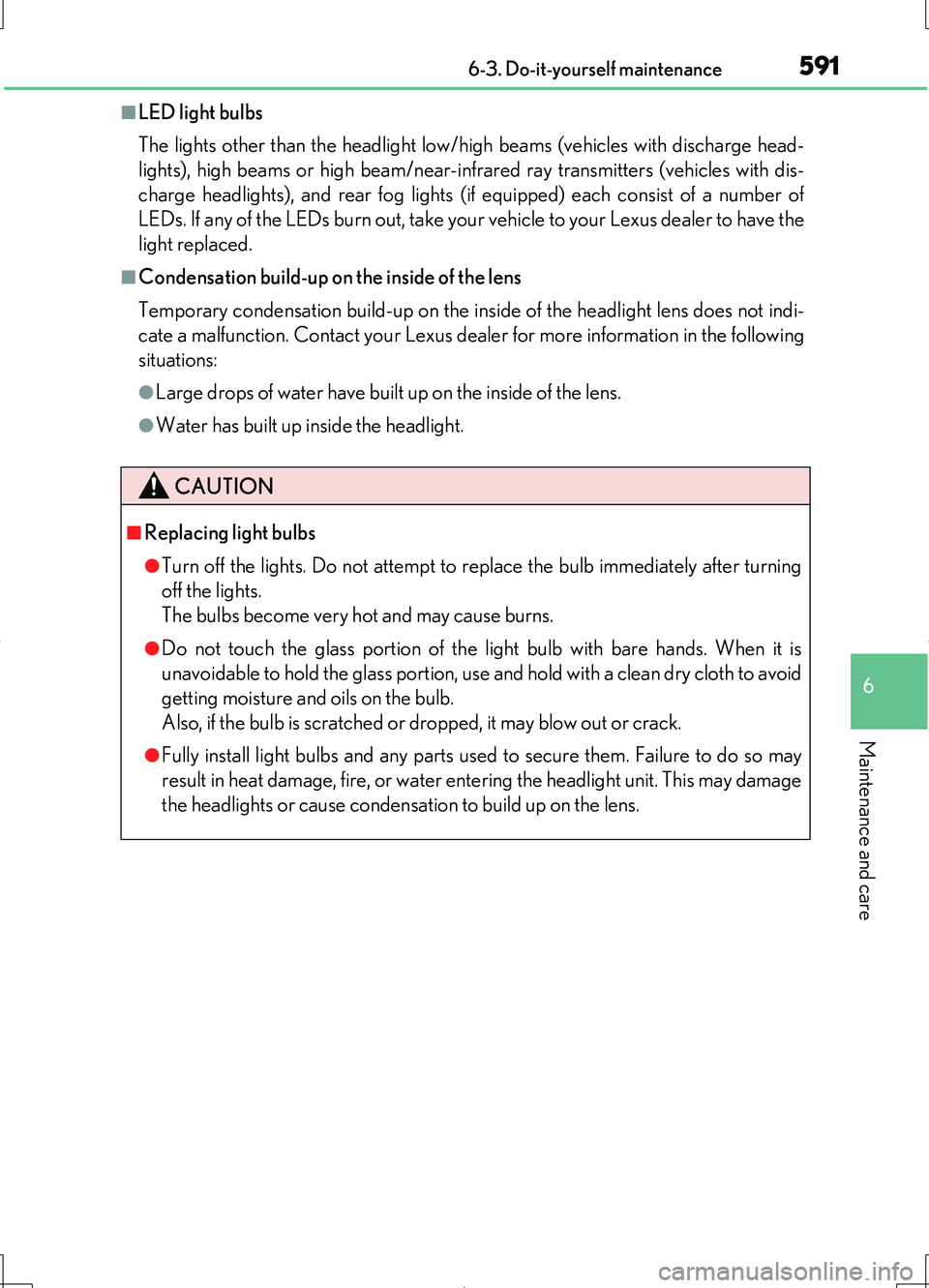
5916-3. Do-it-yourself maintenance
6
Maintenance and care
LS460/LS460L_GE (OM50G06E)
■LED light bulbs
The lights other than the headlight low/high beams (vehicles with discharge head-
lights), high beams or high beam/near-infrared ray transmitters (vehicles with dis-
charge headlights), and rear fog lights (if equipped) each consist of a number of
LEDs. If any of the LEDs burn out, take your vehicle to your Lexus dealer to have the
light replaced.
■Condensation build-up on the inside of the lens
Temporary condensation build-up on the inside of the headlight lens does not indi-
cate a malfunction. Contact your Lexus de aler for more information in the following
situations:
●Large drops of water have built up on the inside of the lens.
●Water has built up inside the headlight.
CAUTION
■Replacing light bulbs
●Turn off the lights. Do not attempt to replace the bulb immediately after turning
off the lights.
The bulbs become very hot and may cause burns.
●Do not touch the glass portion of the light bulb with bare hands. When it is
unavoidable to hold the glass portion, use and hold with a clean dry cloth to avoid
getting moisture and oils on the bulb.
Also, if the bulb is scratched or dropped, it may blow out or crack.
●Fully install light bulbs and any parts used to secure them. Failure to do so may
result in heat damage, fire, or water entering the headlight unit. This may damage
the headlights or cause condensation to build up on the lens.
Page 592 of 708
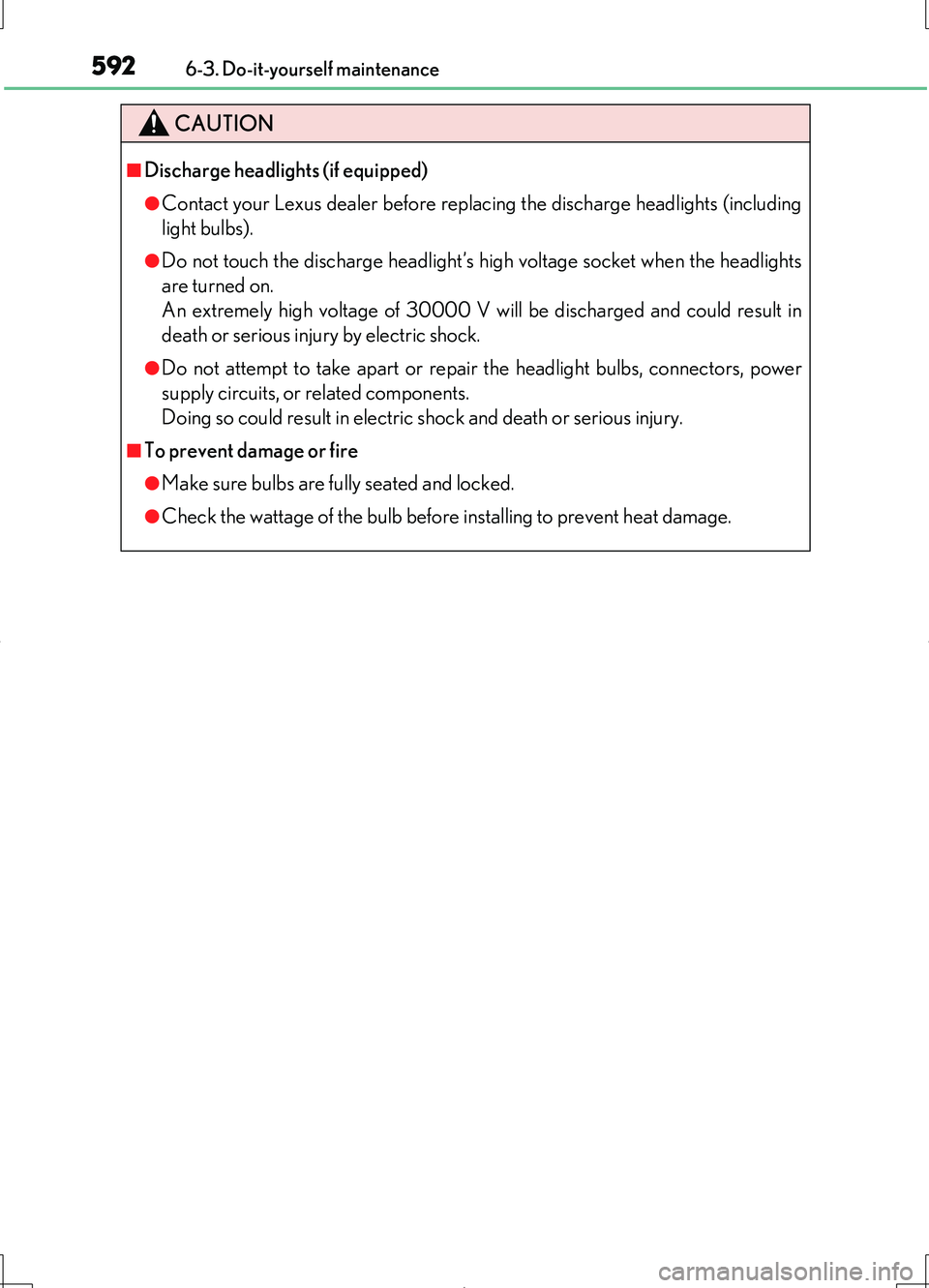
5926-3. Do-it-yourself maintenance
LS460/LS460L_GE (OM50G06E)
CAUTION
■Discharge headlights (if equipped)
●Contact your Lexus dealer before replacing the discharge headlights (including
light bulbs).
●Do not touch the discharge headlight’s high voltage socket when the headlights
are turned on.
An extremely high voltage of 30000 V will be discharged and could result in
death or serious injury by electric shock.
●Do not attempt to take apart or repair the headlight bulbs, connectors, power
supply circuits, or related components.
Doing so could result in electric shock and death or serious injury.
■To prevent damage or fire
●Make sure bulbs are fully seated and locked.
●Check the wattage of the bulb before installing to prevent heat damage.
Page 593 of 708
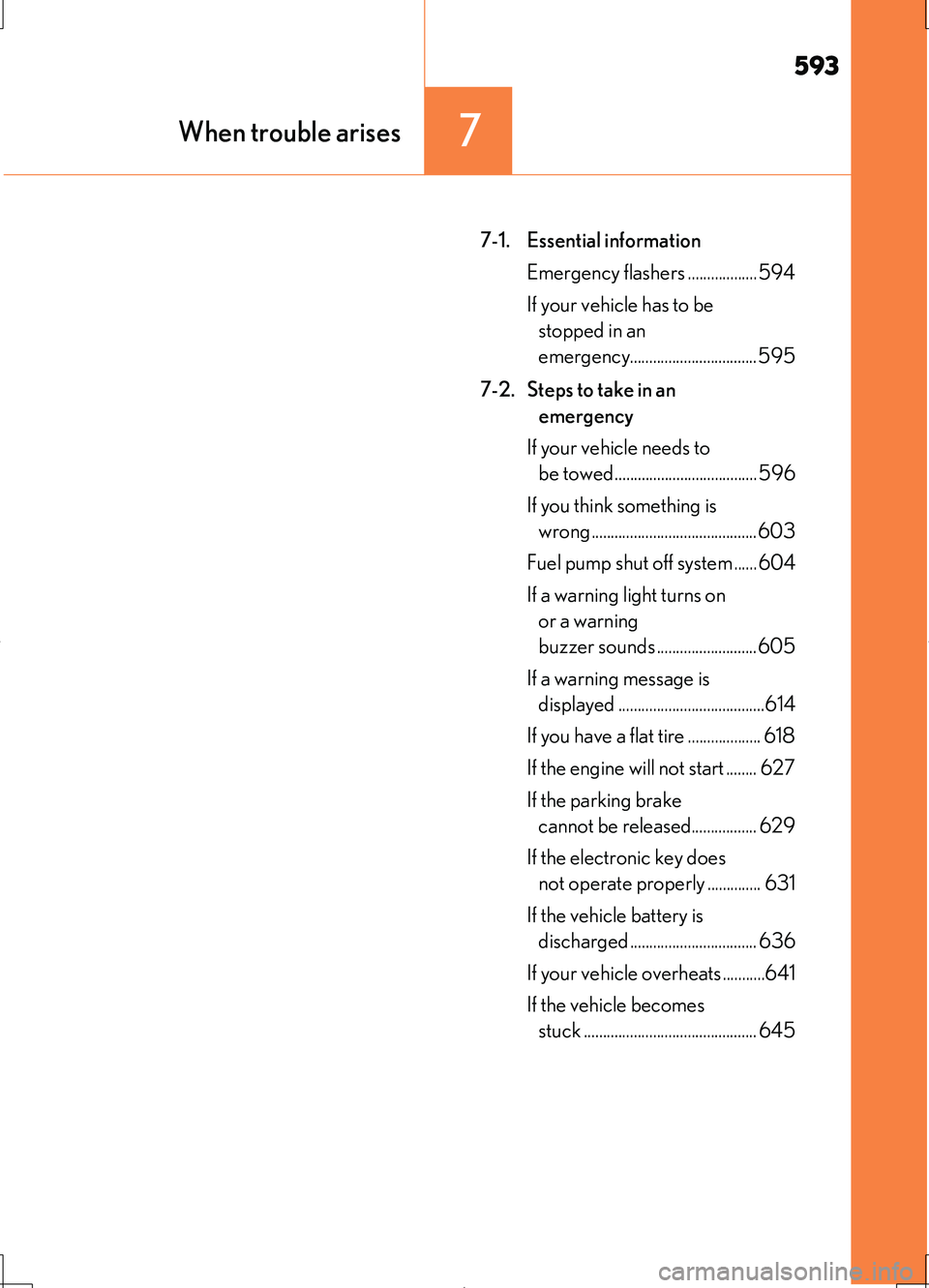
593
7When trouble arises
LS460/LS460L_GE (OM50G06E)
7-1. Essential information
Emergency flashers .................. 594
If your vehicle has to be
stopped in an
emergency.................................595
7-2. Steps to take in an
emergency
If your vehicle needs to
be towed..................................... 596
If you think something is
wrong...........................................603
Fuel pump shut off system ......604
If a warning light turns on
or a warning
buzzer sounds ..........................605
If a warning message is
displayed ......................................614
If you have a flat tire ................... 618
If the engine will not start ........ 627
If the parking brake
cannot be released................. 629
If the electronic key does
not operate properly .............. 631
If the vehicle battery is
discharged ................................. 636
If your vehicle overheats ...........641
If the vehicle becomes
stuck ............................................. 645
Page 594 of 708
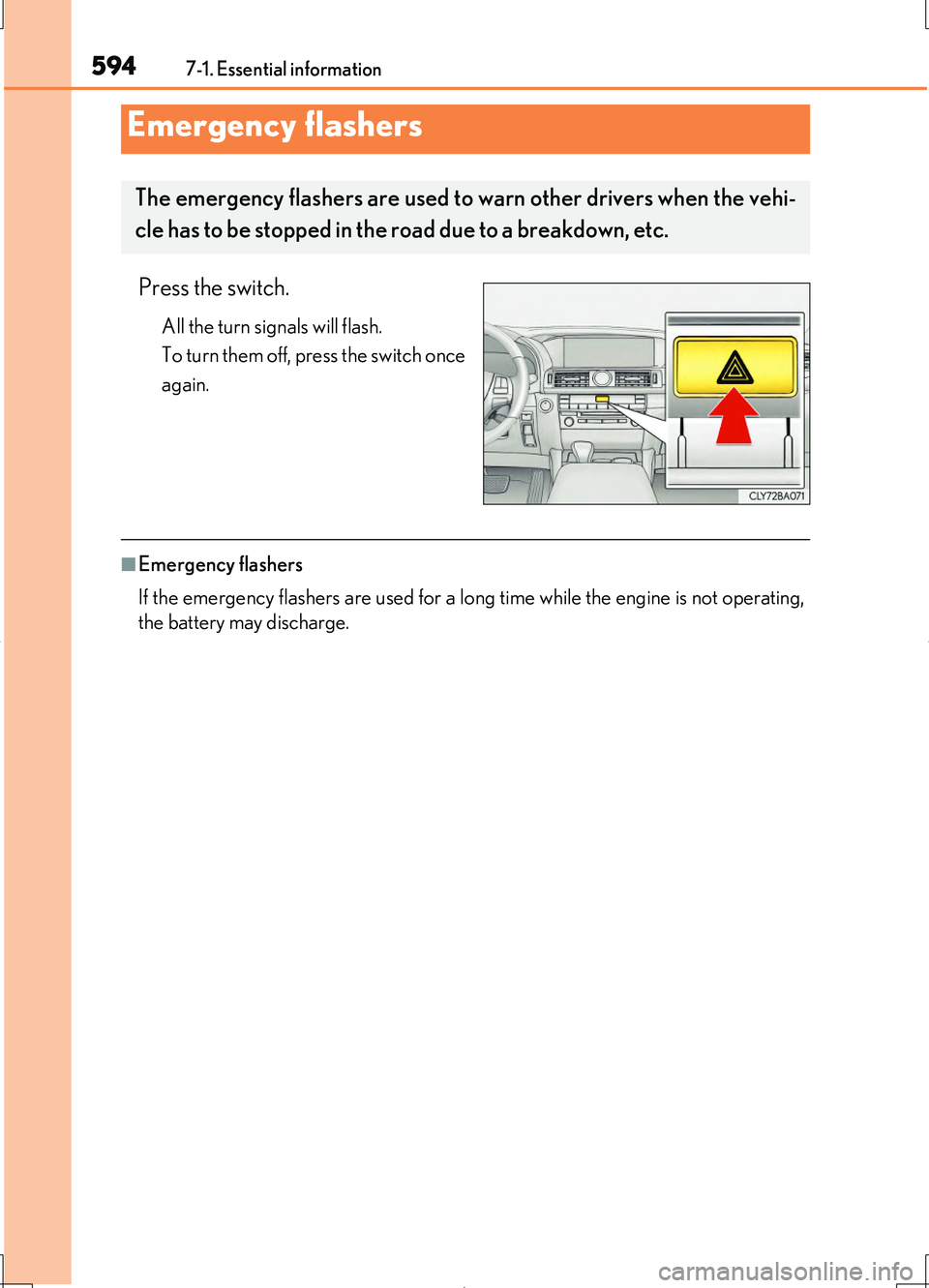
594
LS460/LS460L_GE (OM50G06E)
7-1. Essential information
Press the switch.
All the turn signals will flash.
To turn them off, press the switch once
again.
■Emergency flashers
If the emergency flashers are used for a long time while the engine is not operating,
the battery may discharge.
Emergency flashers
The emergency flashers are used to warn other drivers when the vehi-
cle has to be stopped in the road due to a breakdown, etc.
Page 595 of 708
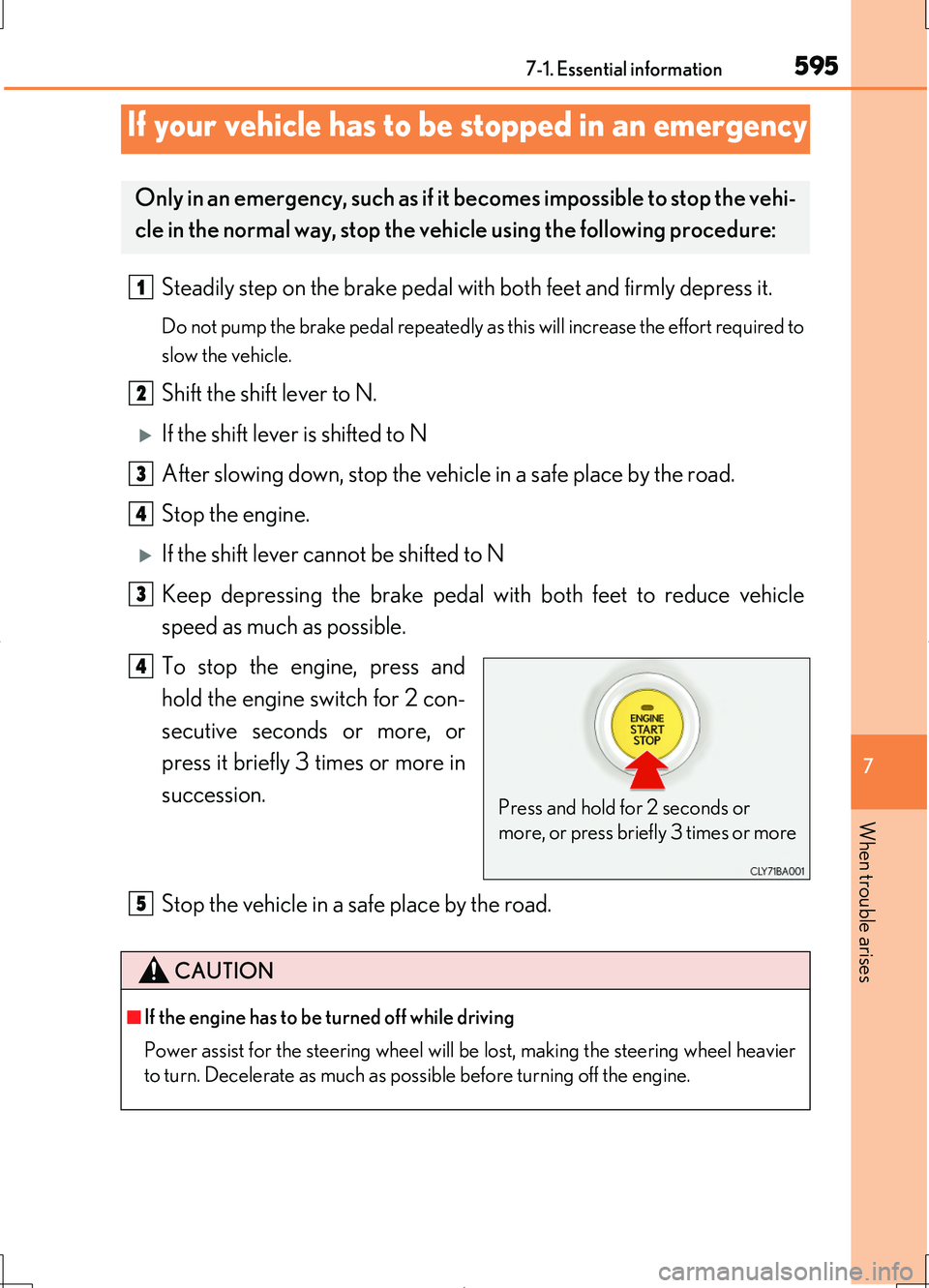
5957-1. Essential information
7
When trouble arises
LS460/LS460L_GE (OM50G06E)
Steadily step on the brake pedal with both feet and firmly depress it.
Do not pump the brake pedal repeatedly as this will increase the effort required to
slow the vehicle.
Shift the shift lever to N.
If the shift lever is shifted to N
After slowing down, stop the vehicle in a safe place by the road.
Stop the engine.
If the shift lever cannot be shifted to N
Keep depressing the brake pedal wi th both feet to reduce vehicle
speed as much as possible.
To stop the engine, press and
hold the engine switch for 2 con-
secutive seconds or more, or
press it briefly 3 times or more in
succession.
Stop the vehicle in a safe place by the road.
If your vehicle has to be stopped in an emergency
Only in an emergency, such as if it becomes impossible to stop the vehi-
cle in the normal way, stop the vehicle using the following procedure:
1
2
3
4
3
Press and hold for 2 seconds or
more, or press briefly 3 times or more
4
CAUTION
■If the engine has to be turned off while driving
Power assist for the steering wheel will be lost, making the steering wheel heavier
to turn. Decelerate as much as possible before turning off the engine.
5
Page 596 of 708
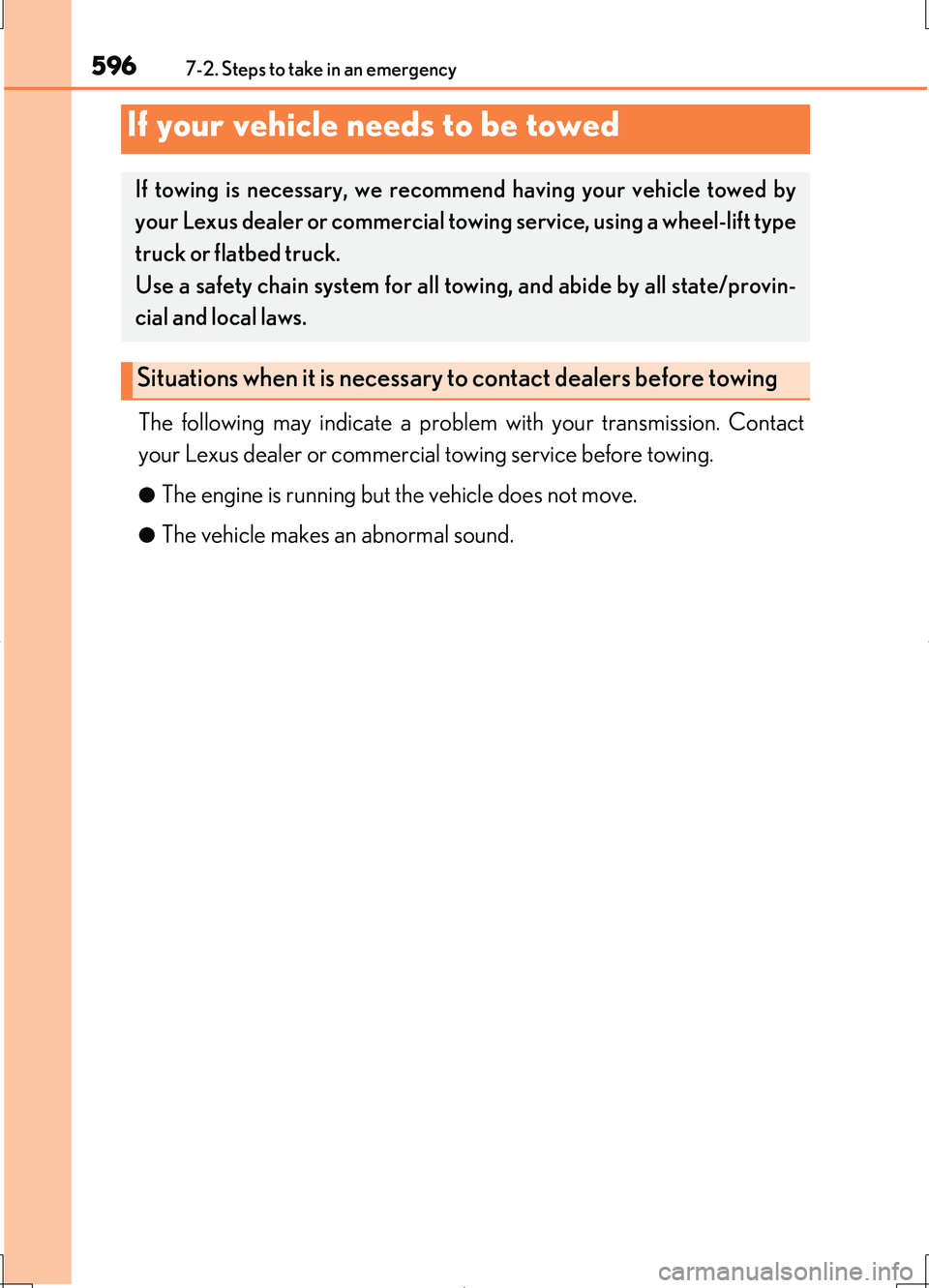
596
LS460/LS460L_GE (OM50G06E)
7-2. Steps to take in an emergency
The following may indicate a problem with your transmission. Contact
your Lexus dealer or commercial towing service before towing.
●The engine is running but the vehicle does not move.
●The vehicle makes an abnormal sound.
If your vehicle needs to be towed
If towing is necessary , we recommend having your vehicle towed by
your Lexus dealer or commercial to wing service, using a wheel-lift type
truck or flatbed truck.
Use a safety chain system for all to wing, and abide by all state/provin-
cial and local laws.
Situations when it is necessary to contact dealers before towing
Page 597 of 708
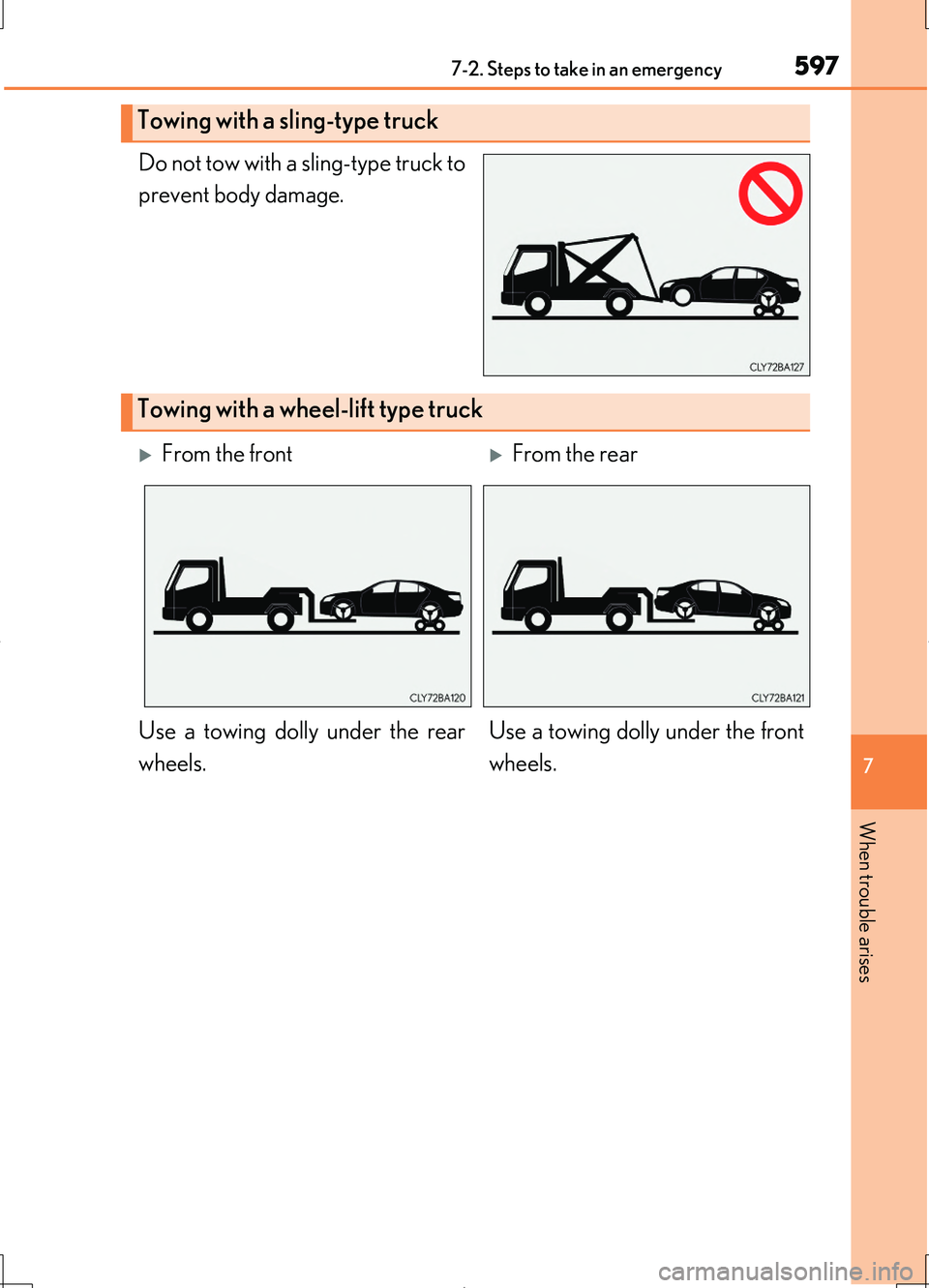
5977-2. Steps to take in an emergency
7
When trouble arises
LS460/LS460L_GE (OM50G06E)
Do not tow with a sling-type truck to
prevent body damage.
Towing with a sling-type truck
Towing with a wheel-lift type truck
From the frontFrom the rear
Use a towing dolly under the rear
wheels.
Use a towing dolly under the front
wheels.
Page 598 of 708
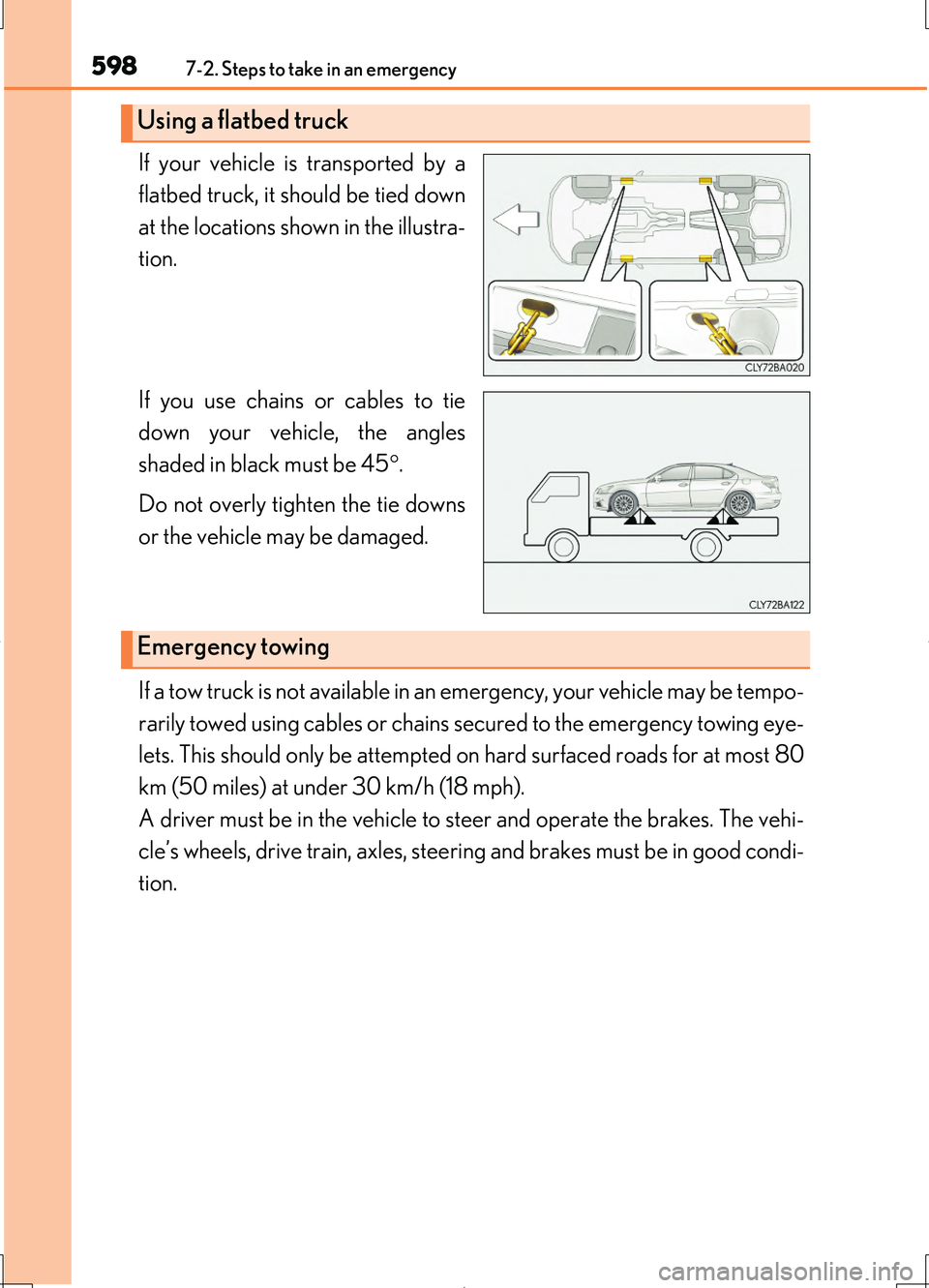
5987-2. Steps to take in an emergency
LS460/LS460L_GE (OM50G06E)
If your vehicle is transported by a
flatbed truck, it should be tied down
at the locations shown in the illustra-
tion.
If you use chains or cables to tie
down your vehicle, the angles
shaded in black must be 45 .
Do not overly tighten the tie downs
or the vehicle may be damaged.
If a tow truck is not available in an emergency, your vehicle may be tempo-
rarily towed using cables or chains secured to the emergency towing eye-
lets. This should only be attempted on hard surfaced roads for at most 80
km (50 miles) at under 30 km/h (18 mph).
A driver must be in the vehicle to steer and operate the brakes. The vehi-
cle’s wheels, drive train, axles, steering and brakes must be in good condi-
tion.
Using a flatbed truck
Emergency towing
Page 599 of 708
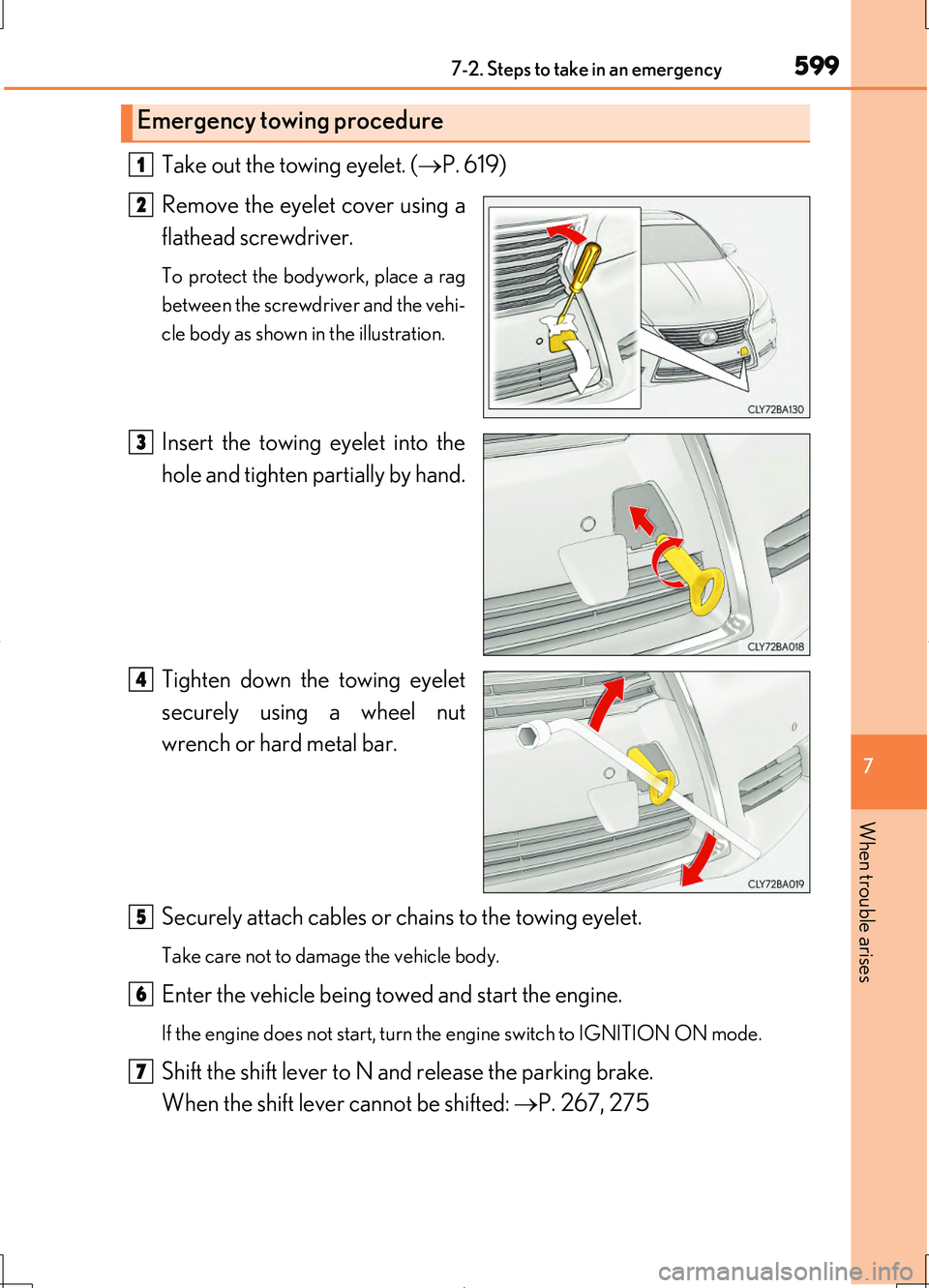
5997-2. Steps to take in an emergency
7
When trouble arises
LS460/LS460L_GE (OM50G06E)
Take out the towing eyelet. (P. 619)
Remove the eyelet cover using a
flathead screwdriver.
To protect the bodywork, place a rag
between the screwdriver and the vehi-
cle body as shown in the illustration.
Insert the towing eyelet into the
hole and tighten partially by hand.
Tighten down the towing eyelet
securely using a wheel nut
wrench or hard metal bar.
Securely attach cables or chains to the towing eyelet.
Take care not to damage the vehicle body.
Enter the vehicle being towed and start the engine.
If the engine does not start, turn the engine switch to IGNITION ON mode.
Shift the shift lever to N and release the parking brake.
When the shift lever cannot be shifted: P. 267, 275
Emergency towing procedure
1
2
3
4
5
6
7
Page 600 of 708
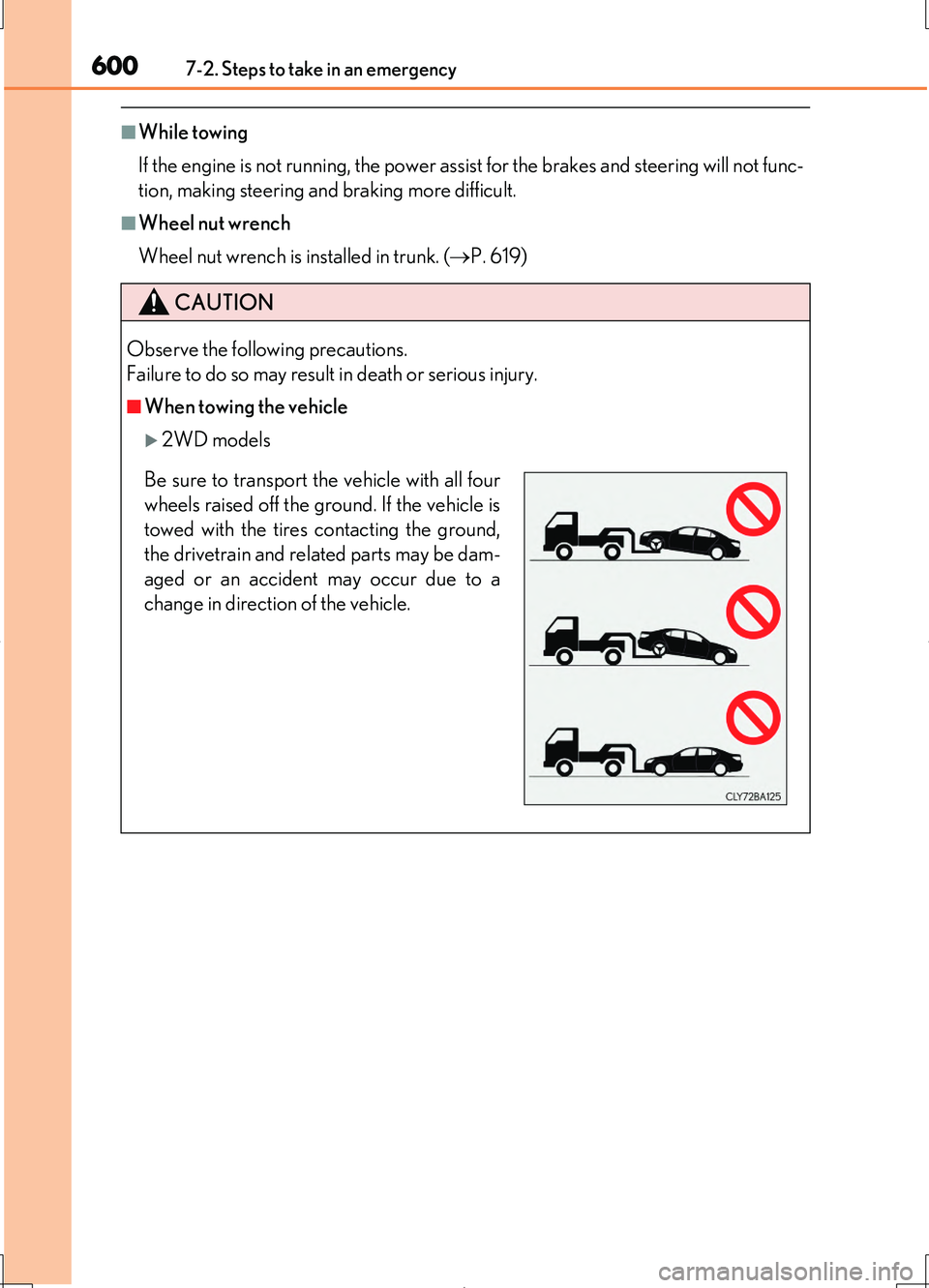
6007-2. Steps to take in an emergency
LS460/LS460L_GE (OM50G06E)
■While towing
If the engine is not running, the power assist for the brakes and steering will not func-
tion, making steering and braking more difficult.
■Wheel nut wrench
Wheel nut wrench is installed in trunk. ( P. 619)
CAUTION
Observe the following precautions.
Failure to do so may result in death or serious injury.
■When towing the vehicle
2WD models
Be sure to transport the vehicle with all four
wheels raised off the ground. If the vehicle is
towed with the tires contacting the ground,
the drivetrain and related parts may be dam-
aged or an accident may occur due to a
change in direction of the vehicle.